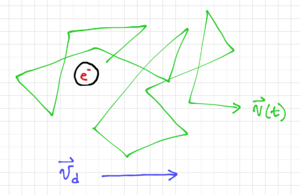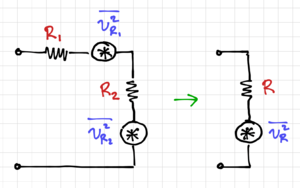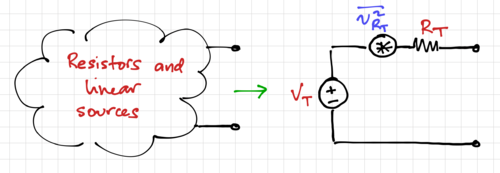Electronic Noise
In this module, we consider the noise generated by the electronic devices themselves due to the (1) random motion of electrons due to thermal energy and (2) the discreteness of electric charge. We see this as thermal noise in resistances, and shot noise in PN junctions. In MOS transistors, we also see flicker noise. This noise is not fundamental, but is due to the way MOS transistors are manufactured, This added uncertainty in the voltages and currents limit the smallest signal amplitude or power that our circuits can detect and/or process, limiting the transmission range and power requirements for reliable communications. Note that purely reactive elements, i.e. ideal inductors and capacitors, do not generate noise, but they can shape the frequency spectrum of the noise.
Contents
Modeling Noise
Since electronic noise is random, we cannot predict its value at any given time. However, we can describe noise in terms of its aggregate characteristics or statistics, such as its probability distribution function (pdf). As expected from the Central Limit Theorem, the pdf of the random movement of many electrons would approach a Gaussian distribution with zero mean since the electrons will move around instantaneously, but without any excitation, it will, on the average, stay in the same point in space. If we add an electric field, then the electron will move with an average drift velocity, , but at any point in time, it would be moving with an instantaneous velocity , as shown in Fig. 1. Note that is the electron mobility.
Noise Power
Aside from the mean, to describe a zero-mean Gaussian random variable, , we need the variance, , or the mean of . For random voltages or currents, , this is equal to the average power over time, normalized to :
-
(1)
-
Thus, to describe noise, we can use its variance, or equivalently its average power. Fig. 2 illustrates the difference between two noise signals with different variances. Recall that , the square root of the variance, is the standard deviation.
Consider a noise voltage in time, , similar to the ones depicted in Fig. 2. The mean is then:
-
(2)
-
The variance, however, is non-zero:
-
(3)
-
We can also calculate the root-mean-square or RMS as:
-
(4)
-
Noise Power Spectrum
We can also examine the noise in the frequency domain, specifically, how noise power is distributed over frequency. Many noise sources are white, i.e. the noise power is distributed evenly across all frequencies, as seen in Fig. 3. Thus, white noise is totally unpredictable in time since there is no correlation between the noise at time and the noise at time , no matter how small is, since the likelihood of a high frequency change (small ) and a low frequency change (large ) are the same.
The noise power should be the same, whether we obtain it from the time or frequency domain. Thus, calculating the noise power in time and in frequency, and equating the two, we get:
-
(5)
-
Where is the noise power spectral density in . An alternate representation of the noise spectrum is the root spectral density, , with units of .
Signal-to-Noise Ratio
In general, we try to maximize the signal-to-noise ratio (SNR) in a communication system. For an average signal power , and an average noise power , the SNR in dB is defined as:
-
(6)
-
Again note that we are referring to random noise and not interference or distortion.
Resistor Noise
Due to the random thermal motion of charge carriers, we get thermal noise, and we observe it as voltage and current noise in resistive circuit elements that is proportional to absolute temperature. We expect this to be the case since at higher temperatures, electrons and holes have higher energy, leading to larger instantaneous velocities, and thus larger excursions from the mean velocity, e.g. from an electric field-induced drift velocity.
Modeling Thermal Noise in Resistors
Consider the noisy resistor in Fig. 1. We can model this as a noiseless resistor in series with a voltage noise generator, or a noiseless resistor in parallel with a current noise generator. Since we cannot predict the voltage or current noise at any point in time, we can instead specify the noise mean square voltage spectral density over a unit bandwidth, :
-
(7)
-
Where is Boltzmann's constant, equal to and is the temperature in Kelvin. The total integrated noise power is then:
-
(8)
-
Where is the observation bandwidth. Alternatively, we can specify the total integrated noise power from the noise current generator:
-
(9)
-
Thermal noise is white noise, since is constant over frequency, and hence the noise generators have white power spectral densities, as shown in Fig. 2. Just like any small signal, the shape of the power spectral density can be shaped by the frequency response of the rest of the circuit.
Also note that the polarity of the noise generators are intentionally not specified in the symbols shown in Fig. 1, since the noise voltage or current can take on positive or negative values at any given time.
For example, a resistor with at , the voltage noise power is:
-
(10)
-
Which gives us:
-
(11)
-
For a measurement bandwidth of , we get . This is the smallest voltage, or the minimum detectable signal we can resolve across this resistor with this bandwidth, i.e. the smallest voltage we can distinguish from the thermal noise of the resistor.
Noise in Resistor Circuits
Consider two noisy resistors in series, as shown in Fig. 3. The equivalent resistance of the series circuit is , and since we can sum the voltage noise powers, we get:
-
(12)
-
It is important to remember that the noise power is additive, but the noise voltages and currents are not, since we do not know the phase of these signals at a given point in time. Similarly, for the parallel resistor circuit in Fig. 4, the equivalent conductance is , and the resulting equivalent current noise generator is:
-
(13)
-
In adding the noise powers, we assumed that the noise generators are independent of each other, i.e. the noise sources are uncorrelated. We will look at the case of correlated noise sources later.
Extending these definitions to any arbitrary resistive circuit, we can determine the equivalent Thevenin or Norton equivalent circuit, as illustrated in Fig. 5, as well as the noise associated with the Thevenin resistance, , as:
-
(14)
-





















































